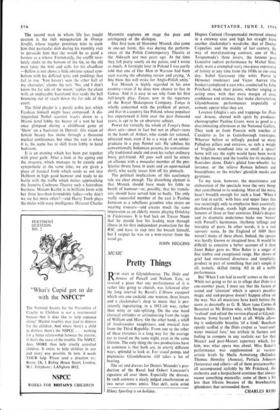MU SIC
Pretty Things
Rum start at Glyndebourne. The Dido and ,Aeneas of Purcell and Nahum Tate, so revered a piece that any performance of it is rather like going to church, was followed after the long interval by Ravel's L'Heure espagnol which sets one cuckold, one wanton, three lovers and a clockmaker's shop to music that is per- sistently ingratiating, in a 1911-ish way, rather than witty or side-splitting. On the one hand classical attitudes or attitudinising from the reign of William and Mary. On the other hand, a whiff of boulevardier naughtiness and musical luxe from the Third Republic. From one to the other of these extremes is a long way for the average ear to travel on the same night, even in the same lifetime. The only thing the two productions have in common is that both are, in utterly different ways, splendid to look at. For visual pomps and piquancies Glyndebourne still takes a lot of beating.
The set and dresses for Dennis Maunder's pro- duction of the Ravel had Osbert Lancaster's signature all over them. Especially the dresses. In such contexts a nicely judged anachronism or two never comes amiss. That deft, eerie artist Hilary Spurling is on holiday.
Hugues Cuenod (Torquemada) twittered around in a cutaway coat and high hat straight from another clockmaker's wardrobe, that of Doctor Coppelius, and the middle of last century. By way of moral-pointing contrast, one of Mrs Torquemada's three lovers, the fatuous poet Gonzalve (adroit performance by Michel She- chal), wore a crumpled ivory two-piece expressive of fatuity at any time from the 1930s to our own day. Isabel Garcisanz (the wife). Pierre le Hernonet (muleteer) and Victor Autran (the banker) completed a cast who, conducted by John Pritchard, made their points, whether singing or acting ones, with that extra margin of ease, confidence and intimacy that make characteristic Glyndebourne performances (especially of comedy opera) what they are.
Lorenzo Ghiglia's sets and trappings for Dido and Aeneas, abetted with spirit by producer- choreographer Pauline Grant, were as good as a discriminating afternoon at the National Gallery. They took us from Poussin with touches of Canaletto as far as Gainsborough treescapes. Whoever before so tellingly packed so many Palladian pillars and entraves, so rich a weight of Virgilian woodland into so small a space? Some will say the night would have been worth the ticket money and the trouble for its incidental flourishes alone. Dido's gilded four-wheeler, for instance; or the relievo Roman helmets and breastplates; or the witches' ghoulish masks and gyrations.
To my taste, however, the massiveness and elaboration of the spectacle were the very things that contributed to its undoing. Most of the music hasn't breadth enough for such a load. 'When I am laid in earth,' with bass and upper lines that rise recurringly only to emphasise their essentially deathward droop, stands high among the great laments of three or four centuries. Dido's despair and its dramatic undertones make one 'weave' with Purcell's harmonies, rhythmic tollings and interplay of parts. In other words, it is a real operatic scena. In the England of 1689 there weren't many of these about. Indeed, the species was hardly known or imagined here. It would be difficult to conceive a better account of it than Janet Baker gave us. Miss Baker is a singer of fine timbre and exceptional range. Her shows of grief had emotional directness and simplicity, product in part of something that isn't simple at all, namely, skilled timing. All in all a noble performance.
But 'When I am laid in earth' comes at the end. While not going so far as to allege that Dido is a one-number piece, I must say that the fusion of sound and 'situation' which is opera's peculiar magic and end-purpose doesn't happen often on the way. Not all musicians have knelt before the score as devotedly as G. B. Shaw (qua Corno di Bassetto) or Mr Britten who, with Imogen Hoist, 'realised' and edited the version played at Glynde- bourne. Some haven't knelt at all. While allow- ing it undeniable beauties 'of a kind,' Beecham openly scoffed at the Dido corpus as 'toast-and- water musical fare,' too archaic in facture and feeling to compete in any realistic ear for that Mozart and post-Mozart repertory which, for him, was what opera was about. Miss Baker's performance was supplemented at various artistic levels by Sheila Armstrong (Belinda), Thomas Hemsley (Aeneas), Patricia Johnson (Sorceress) and others—all of them praiseworthy; all accompanied stylishly by Mr Pritchard, the orchestra and a harpsichord continuo that always meant something musically; some of them a bit less than lifesize because of the browbeating splendours that surrounded them.
CHARLES REID


































 Previous page
Previous page